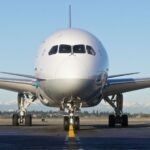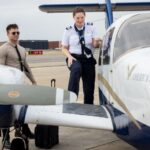By: Steven Daun, National Chief Pilot
It does not take long during primary flight training to realize that a pilot needs to adapt their mindset when flying into different airports. Controlled and uncontrolled airports are typically the primary difference. But each of those can be further divided into “busy” and “not busy.” So how does one prepare to fly into these different types of airports?
Sufficient preparation can mean the difference between a safe transition or having the tower ask you to call a special number when you land. This does not only pertain to the general aviation pilot; it also pertains to highly experienced airline pilots who may not fly into uncontrolled airports that often.
There is no excuse not to be prepared to fly into an unfamiliar airport in today’s world. Between airport web pages, Google Maps, YouTube, chat rooms, and the FAA website, not to mention countless other resources, a pilot does not have any excuse if they have a problem.
Everyone has their preferences as to where they begin. It is difficult for anyone to say that one is better than the next. Here are some practices and considerations that I use when flying into busy controlled and uncontrolled airports.
Busy Uncontrolled Airports
- Locate the webpage(s) for the airport and determine if there are any special arrival and or departure requests. Check for any special notes or suggestions posted by the airport manager.
- Airport Diagram. See if there is an airport diagram or airport picture either from the FAA website or from the airport. Become familiar with the runways, taxiways, and ramp areas.
- Approaches. If you are an instrument-rated pilot, review all of the approaches to the airport. Go through an exercise of approaching the airport from all different directions and figure out your transition, approach, and missed approach. This will save you much stress later on.
- Get a lay of the land. Study the appropriate sectional or TAC chart and become familiar with the terrain, airspace, and landmarks. Find the airport on Google Maps in satellite mode and see what the airport and surrounding area looks like from the different possible approaches. Gain a better reference and sight picture of key landmarks, terrain, and the airport layout.
- Call the FBO. You can call the local FBO and find out what times are the busiest times at the airport and where is the preferred parking spot for your aircraft at the time of arrival. This is also an excellent time to double-check and verify the local traffic patterns at the airport.
- Check the frequencies. Check and double-check that you have the appropriate Unicom frequency for the airport. You can also verify this when you call the FBO. There is nothing worse than dialing in a frequency only to find out later that everyone else uses a secondary frequency.
- Check the NOTAMS. This is very important in today’s environment. In fact, when departing from an unfamiliar, uncontrolled airport, I make it a point to call FSS and speak with a briefer. They know the nuances of the local airspace and can provide you with additional information that you may not be able to get anywhere else.
Busy Controlled Airports
- Locate the webpage(s) for the airport and determine if there are any special arrival and or departure requests. Check for any special notes or suggestions posted from the airport manager and whether air carriers or the military use the airport. This is important so that you will know which ramps to stay away from and which ramps are used for general aviation.
- Airport Diagram. Review the airport diagram and become familiar with the runways, taxiways, and ramp areas.
- Approaches. If you are an instrument-rated pilot, review all the approaches to the airport. Go through an exercise of approaching the airport from all different directions and figure out your transition, approach, and missed approach. This will save you much stress later.
- Get a lay of the land. Study the appropriate sectional or TAC chart and become familiar with the terrain, airspace, and landmarks. Find the airport on Google Maps in satellite mode and see what the airport and surrounding area looks like from the different possible approaches. Gain a better reference and sight picture of key landmarks, terrain, and the airport layout.
- Find your parking. Many controlled airports have more than one FBO. Determine which FBO you will use and how to access their ramp from each of the runways.
- Live ATC. Log in to Live ATC and listen to the ATIS (approach, tower, ground, and departure) recordings for the airport. This will help prepare you for any accent or slang variations that you may not expect. It will also prepare you for local procedures and landmarks used by ATC.
- Check the frequencies. Check and double-check that you have the appropriate ATIS frequencies for the airport. I also find the phone number for airport operations and the tower cab in case I have a comm issue.
- Check the NOTAMS. This is very important in today’s environment. In fact, when departing from an unfamiliar, uncontrolled airport, I make it a point to call FSS and speak with a briefer. They know the nuances of the local airspace and can provide you with additional information that you may not be able to get anywhere else.
- Find someone who has been there if you are flying into a very busy and large controlled airport, its usually a good idea to fly there (if possible) with someone who has been there before. It is very easy to get confused with multiple taxiways and runways. It can also be challenging to navigate your way to a particular ramp. At many of these airports, especially during busy times, getting a word in edgewise on the radio can be challenging. Any delay or hesitation in your movement around the airport can hamper the traffic flow. You could find yourself in a “penalty box,” waiting for the traffic to slow down before you can move again.
- Which runway. Many large controlled airports use specific landing runways depending on which ramp you are going to park on. Knowing this ahead of time can reduce confusion and frustration for you and the controller.
- No practice. During busy times very few of these airports will permit touch and goes, or practice missed approaches. Both can cause delays or potential delays for inbound traffic. Unless the controller is clear and approves alternative requests, they expect you to land, exit the runway and head straight to the ramp with little or no assistance.










